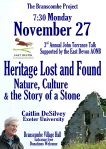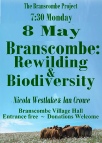







The Branscombe Project



9-
Nomadic Pastoralism in Mongolia
Patrick Dillon
For millennia, the temperate landscapes of south-
But what might have emerged had the climate been less benign and the topography more challenging?

13-
Art & Archaeology
Digging Deep into Landscape
Rose Ferraby

10-
The Burnt House at Weston
Stuart Blaylock & Barbara Farquharson
27-
The Third Annual John Torrance Talk
Heritage Lost and Found:
Nature, Culture & the Story of a Stone
Caitlin DeSilvey (Exeter University)
A talk about recent work with the heritage sector exploring how the ‘loss’ of (architectural and horticultural) heritage due to accelerated climate change can also generate opportunities for creating new links to the past, and pathways to a resilient future.


12-
Dorstone Hill & Arthur’s Stone:
A Neolithic Landscape in Herefrodshire
Julian Thomas

13-
A New Natural History of Britain
Naomi Sykes
8-
Branscombe: Rewilding & Biodiversity
Nicola Westlake & Ian Crowe


8-
An Insight into My World as a Wildlife Photographer
Robin Morrison

11-
Making a Palaeolithic Flint Hand Axe
Mark Edmonds
22-
Down Weston Combe and into the Meadow
Reflections on Nature and Learning
David Selby

25 Nov 2024
The Annual John Torrance Talk
Red River Project
John Wedgewood Clarke
The Red River may be small and ugly in places, but it tells us a lot about what we value and our attitude to the natural world. It has been polluted for centuries and evolved its own unique ecological response to the impact of tin mining, including trout adapted to its toxic water. Tidying it up has, in the past, involved destroying both industrial ruins and unofficial playgrounds, as well as unique hot-


27 Jan 2025
Vindolanda
Andrew Birley
Extraordinary finds from the peatlands alongside Hadrian’s Wall. Roman letters written on birch bark and much more, under threat as the peatlands dry out.

24 Feb 2025
Dr Rowe & Branscombe’s Bastard Fauna
Stratigraphy, paleocology & field study of local Cretaceous chalk
Rob Beard
Fossil hunting in the Branscombe area is not nearly as well regarded as in the famous Jurassic exposures of West Dorset. Fossils are fewer in East Devon and harder to find. When good specimens are recovered, they are often beautifully preserved and find rates are sufficient to support a small group of collectors from the local Cretaceous strata.
24 Mar 2025
Bog Burials
Face to Face with the Past
Mel Giles


24 Nov 2025
Gatcombe Farm
Talking about badgers and different ways of farming.
Robert Reed
| Winter Talks |
| Archive Misc |
| Barbara Bender |
| Geoff Squire |
| John Torrance |
| Unpublished Papers |
| Postcard Archive |
| Photographic Archive |
| Talks Page 1 |
| Talks Page 2 |
| Talks Page 3 |
| Talks Page 4 |
| Talks Page 5 |